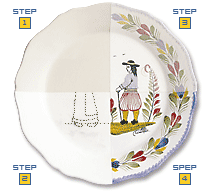| A special know-how that does not leave room for error is maintained at the Faïencerie d’Art Breton.
Here are the four principal steps of the manufacture of Quimper pottery.
|
|
| Step 1 > The clay mixture and the bisque |
|
|
The clay mixture for pottery is composed of clay, talc, limestone, and silica. After the minerals are ground and water is added, the resulting mixture is shaped.
|
|
 |
The shaping is done by pressing, calibration, slip-casting in plaster molds, or even hand-turning (which is the case for certain pieces whose manufacture the Faïencerie d’Art Breton entrusts to area artisans).
After drying and finishing, the pieces pass one night in a kiln for a first firing at 1050° C.
Particularly delicate, this process produces a very porous matter called bisque. |
|
|
|
|
|
|

|
|
| Step 3 > The decoration |
|
| Authentic Quimper pottery derives all of its originality from the method by which it is decorated: completely free-hand in a series of quick strokes.
This well-known “Quimper brush stroke” leaves no room for error; the color penetrates the glaze instantly.
 |
|
Each painter has his own brush stroke style, which is as individual as his handwriting. |
This personal expression, validated by his initials, makes each piece different and unique.

|
|
|
|
|
|
|
|
|

|
|
| Step 2 > Glazing |
|
| Before being decorated, the bisque is first glazed.
The glaze is an opaque glass, ground in water. It must have a consistent melting point and an expansion quality identical to the bisque.

|
|
At the Faïencerie d’Art Breton, pieces are glazed by hand with an airbrush. By capillary action, the sprayed glaze fixes itself to the porous bisque with a constant thickness of 4/10 of a millimetre.
|
|
|
|
|
|
|
|

|
|
| Step 4 > The final firing |
|
| The second firing in the kiln gives life to the pottery, revealing the strength of its colors and the shine of the glaze.
The colors are composed of metallic oxides which change during this high-temperature firing; e.g., blue appears as pale pink and, upon being fired, becomes sparkling and intense.
 |
|
The firing cycle – from beginning to end – lasts about 15 hours and the temperature reaches 955° C. |
Around 190° C, one can open the kiln and, in just several minutes, see the colors take on their definitive tones.
|
|
|
|
|
|
|
|